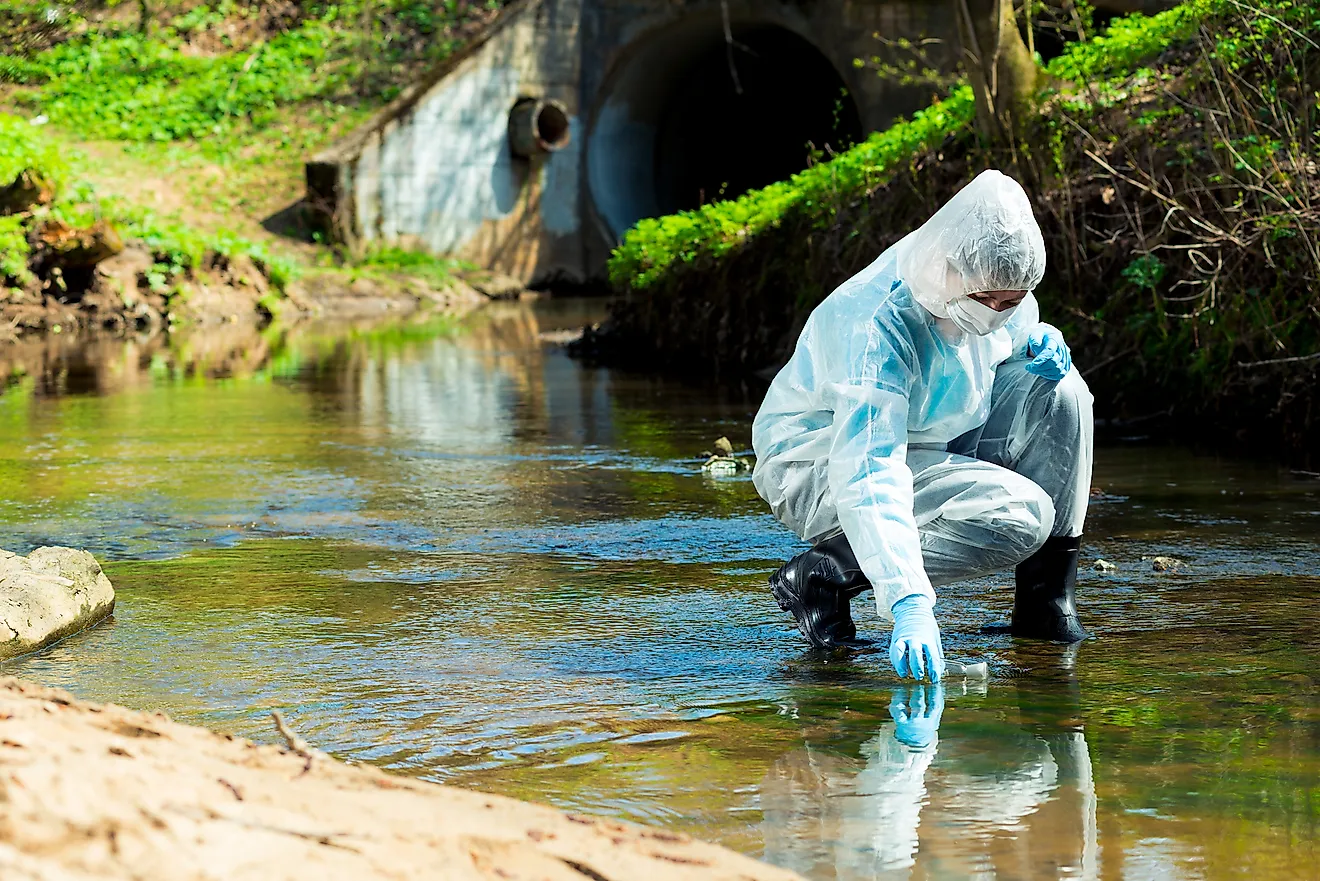Contaminated Drinking Water: Millions Of Americans At Risk, Report Reveals

Table of Contents
The Extent of the Problem: How Many Americans are Affected?
The report paints a disturbing picture of the prevalence of contaminated drinking water across the nation. Millions of Americans, from diverse socioeconomic backgrounds and geographic locations, are exposed to unsafe water sources daily.
Geographic Distribution of Contaminated Water Sources:
The distribution of contaminated water sources is far from uniform. Some regions face significantly higher risks than others. A recent Environmental Protection Agency (EPA) study revealed alarmingly high levels of contaminants in several states.
-
States/Regions with Highest Contamination Levels:
- California (high levels of PFAS in groundwater)
- Michigan (extensive lead pipe contamination)
- Florida (high nitrate levels in agricultural areas)
- Texas (arsenic contamination in certain groundwater sources)
- These figures are based on data from the EPA's 2023 Water Quality Report and various state-level studies.
-
Specific Contaminants: The contaminants vary across locations but commonly include lead, per- and polyfluoroalkyl substances (PFAS), nitrates, arsenic, and other harmful chemicals.
Demographic Disparities in Access to Safe Water:
Access to safe and clean drinking water is not equitable across the US. Low-income communities and communities of color are disproportionately affected by contaminated drinking water.
- Statistics Highlighting Inequality: Studies consistently show that these communities are more likely to have aging water infrastructure and less access to effective water treatment systems.
- Systemic Issues: This inequality is rooted in systemic issues including historical redlining, discriminatory housing policies, and inadequate investment in infrastructure in underserved areas. This creates an environmental justice problem with severe health consequences.
Sources of Water Contamination: Identifying the Culprits
The sources of contaminated drinking water are multifaceted and complex. They range from industrial pollution to aging infrastructure and even naturally occurring contaminants.
Industrial Pollution and its Impact:
Industrial discharge and agricultural runoff significantly contribute to water contamination. Chemicals used in manufacturing processes and pesticides used in agriculture often seep into groundwater and surface water sources, contaminating drinking water supplies.
- Common Industrial Pollutants: Heavy metals (lead, mercury, cadmium), PFAS (found in firefighting foam and various industrial products), and various organic chemicals.
- Long-Term Health Consequences: Exposure to these pollutants is linked to various cancers, developmental problems, reproductive issues, and other severe health complications.
Aging Infrastructure and Leaking Pipes:
A significant portion of America's water infrastructure is aging and deteriorating. Leaking pipes, particularly those made of lead, release harmful contaminants into the water supply.
- Problems with Lead Pipes: Lead pipes leach lead into the water, posing a serious risk, particularly to children. Lead exposure can cause irreversible developmental damage.
- Costs of Upgrading Infrastructure: Replacing aging pipes and modernizing water treatment plants requires significant financial investment, which presents a major challenge for many municipalities.
Natural Occurrences:
Some contaminants occur naturally in groundwater. For instance, arsenic and radon can seep into wells, posing a risk to those who rely on private wells for drinking water.
- Examples of Naturally Occurring Contaminants and their Health Effects: Arsenic can cause skin lesions, cardiovascular issues, and various cancers, while radon exposure increases the risk of lung cancer.
- Testing and Remediation Methods: Regular water testing is crucial for detecting naturally occurring contaminants. Remediation methods, such as water filtration systems or well modifications, can be implemented to address these issues.
Health Risks Associated with Contaminated Drinking Water
Consuming contaminated drinking water carries significant health risks, ranging from short-term ailments to life-altering long-term illnesses.
Short-Term and Long-Term Health Impacts:
The health impacts vary depending on the contaminant and the level of exposure.
- Illnesses Linked to Contaminated Water: Gastrointestinal infections (diarrhea, vomiting), typhoid fever, cholera, developmental problems (neurological impairments, learning disabilities), various cancers (bladder, kidney, liver).
- Severity and Prevalence: The severity of these illnesses varies widely. Some can be mild and self-limiting, while others can be severe, requiring hospitalization and leading to long-term health issues.
Vulnerable Populations and Increased Risk:
Certain populations are more vulnerable to the effects of contaminated drinking water.
- Higher Risk Groups: Children, pregnant women, the elderly, and individuals with weakened immune systems are particularly susceptible to the adverse health effects of contaminated water. Children are especially vulnerable to lead poisoning, which can cause irreparable brain damage.
- Specific Risks for Vulnerable Populations: Pregnant women and fetuses are highly susceptible to the effects of toxins like mercury and PFAS, which can lead to developmental problems. The elderly may have pre-existing conditions that make them more susceptible to waterborne illnesses.
Solutions and Prevention Strategies: What Can Be Done?
Addressing the issue of contaminated drinking water requires a multi-pronged approach involving infrastructure upgrades, strengthened regulations, and increased public awareness.
Investing in Water Infrastructure Upgrades:
Modernizing water treatment facilities and replacing aging pipes is crucial.
- Specific Infrastructure Improvements: Replacing lead pipes, upgrading water treatment plants to remove emerging contaminants (like PFAS), and improving leak detection and repair systems.
- Funding Options and Government Policies: Increased federal and state funding, tax incentives for infrastructure upgrades, and innovative financing mechanisms are essential.
Strengthening Regulations and Enforcement:
Stricter regulations and robust enforcement mechanisms are necessary to prevent contamination at its source.
- Policy Changes: Lowering maximum contaminant levels (MCLs) for various pollutants, strengthening regulations for industrial discharge and agricultural runoff, and increasing penalties for violations.
- Role of Regulatory Agencies: The EPA and state environmental agencies play a critical role in monitoring water quality, enforcing regulations, and ensuring compliance.
Public Awareness and Education:
Educating the public about the risks of contaminated drinking water and how to protect themselves is essential.
- Effective Public Awareness Strategies: Public service announcements, educational campaigns, and community outreach programs.
- Importance of Regular Water Testing: Encouraging individuals to regularly test their water for contaminants, especially those using private wells.
Conclusion
The findings of the recent report highlight the alarming reality that millions of Americans face the risk of consuming contaminated drinking water. The various sources of contamination—industrial pollution, aging infrastructure, and naturally occurring contaminants—pose significant and diverse health risks, particularly to vulnerable populations. Addressing this critical issue requires a concerted effort involving substantial investments in water infrastructure upgrades, stronger regulations and enforcement, and widespread public education.
We must act now. Contact your elected officials to advocate for improved water infrastructure and stricter regulations regarding contaminated drinking water. Test your water regularly, and learn more about the specific contaminants prevalent in your area. The health and well-being of millions depend on our collective action to ensure safe and clean drinking water for all Americans. By working together, we can create a future where access to clean drinking water is a right, not a privilege.

Featured Posts
-
 Police Apprehend Individual Gsw Campus Secure
May 15, 2025
Police Apprehend Individual Gsw Campus Secure
May 15, 2025 -
 Individual Taken Into Custody Gsw Campus Secure
May 15, 2025
Individual Taken Into Custody Gsw Campus Secure
May 15, 2025 -
 Can The Padres Finally Beat The Rockies
May 15, 2025
Can The Padres Finally Beat The Rockies
May 15, 2025 -
 Nhl 25 Arcade Mode Is Back
May 15, 2025
Nhl 25 Arcade Mode Is Back
May 15, 2025 -
 Is It Possible To Bet On The Los Angeles Wildfires Exploring The Dark Side Of Disaster
May 15, 2025
Is It Possible To Bet On The Los Angeles Wildfires Exploring The Dark Side Of Disaster
May 15, 2025
